with Joann Formosa and Manuela McLean
Story by Susan Mackenzie & Photos by Roz Neave
After a little detour when Roz allowed me to navigate (foolish move) we arrive at the Australian Equine Behavioural Centre in Broadford to meet Paralympic gold medallist Joann Formosa, her lovely stallion Worldwide PB and their trainer Manuela McLean. Surrounded by peaceful gum trees the big, cruisey stallion is dressed in his Australian Olympic Team rug and is waiting for his forever-keen rider.
I introduce myself to PB and have a quick pat. The very cool stallion just stands there while Joann is given a leg up, he doesn’t need to be held, he is happy to stand peacefully until Joann is ready for him.
I later learn that PB has very clear rules with himself about when he is a stallion and can act like it, and when he is required to ‘behave in a more gentlemanlike manner’… It all is to do with nudity… If PB has his rug off and is having a shower, and a pretty mare is next to him who is also ‘naked’ then he gets to behave like a stallion, but if he has a rug or a saddle on then he has his mind firmly on being a dressage horse!
“He’s so cool,” says Joann, “At the Sydney CDI we didn’t even really warm up, we just jogged up from the stables! Real professionals just wing it,” she laughs.
Jo says her life would be a lot easier if she could have a little truck to travel with.
“It would be so much easier, I wouldn’t have to put the float on, I could take my electric scooter with me and not have to hire one each time, it would just be so much easier getting around. Overseas, all the riders have sponsors for their trucks but it doesn’t happen here… But I can’t be too greedy, at the end of the day I have got the best thing; I’ve got my horse.”
“I’d only had him seven months when we won gold. We retrained him in seven months and won gold. He’s very cool.”
“But it’s not just me and the horse, it’s the team, it’s all the work up to the competition at the Games. We all won it; it’s ours, everyone who worked towards it.”
“It’s amazing, something I’m so passionate about, how it has affected people in real life ! I rode because I just wanted to go after my dream, but it has inspired so many others.”
Joann has her sights firmly set on the Normandy WEG and is already thinking about the next horse for the Rio Olympics…
“PB will go to Normandy, we’ll do that next year. But he’s 19, Normandy will be his last year. I wouldn’t want to take him to Rio, the climate there is hard on them, it’s a lot of travel, I’d rather keep him here and keep riding him. I couldn’t handle it if anything happened to him.”
I ask how she found the cruisey chestnut…
“Well he wasn’t what I was looking for at all. I thought, oh no not a stallion, not another chestnut [at this point I interrupted with a scolding sound indicating my very chestnut hair!], but I think I saw four horses in 24 hours and when I saw him there was just something about him. I went to see him at Claire Seidl’s and he gave me a hug to start with. Then his rider rode him and I was like, ‘hurry up and get off, I want to get on!’ There was just an electricity with him, I still get that each time.”
“If I fall off and land under him, he just stops and waits and he’s like, ‘what are you doing down there?’ He’s happy being dragged off my scooter, and used as a packhorse. But when you’re on him you feel every bit of muscle and power.”
At this point Manuela brings PB across, “Your sturdy steed awaits”.
I remember watching the Paralympics and wondering how the horses were trained to respond to different aids. Well, that’s what Manuela and Joann have figured out with PB…
It’s all about whip taps. Exact, gentle and precise whip taps in conjunction with seat and rein aids.
It’s two distinct taps with the long whip on his hindquarters to go up a gait; PB bounces into trot. And it’s two subtle taps on his shoulder to go down a gait; this aid is very clear and PB pops back from walk, trot and canter with just two clear taps
on his shoulder.
This aid started when Manuela first worked with the pair and she worked with him on the ground. She initially tapped him on his chest to make him go backwards from halt, to halt from walk and so on. Once this was established Joann pointed out that she couldn’t reach his chest so the aid was adjusted to a tap on his shoulder. “I just touch him, it’s light, I just touch him and he comes back,”
says Joann.
Manu says it’s just the power of positive reinforcement, “once he reacts to the aid, it’s a pat and a scratch and ‘good boy’”.
“Through your trial and error learning they learn that you tap and you tap and they move and you stop tapping. So it’s the release of the tapping that trains, that’s the important thing to remember, the tapping just tells him to do something. So when you release, you might have been releasing at five taps, you just keep practising until you get it down to two taps and to go up a gait. And then what we’ve done is introduce the seat cue to move to the walk or move to the trot. So you go, bum, tap tap, or a word, you go walk on, tap tap. But I mean you can say ‘walk on’ all day and nothing happens so you need something to make it happen. I always see riders pushing and pushing with their bums the whole time, and I say no, we actually want to stay neutral once we’re in the gait. So if it doesn’t work on two taps, and you stop tapping, then you’ve just taught them not to go, to ignore you and that’s not so good.”
“We talk about what Jo can do, for instance the chest tap was too hard for Jo, so it became a shoulder tap. She can’t use the whip in both hands so we have to work around that and our training is just with the whip in one hand.”
I expected some clever work like this, and PB and Jo to look really good, but then Manu asks Jo to shorten the trot, this aid is just one tap on the shoulder, a little wake up call to say, hey, we’re going to trot properly. The horse collects himself and does the most amazing trot, it has lovely cadence and he comes into self-carriage easily. Joann does the same in walk: a very nice medium walk transforms to an impressive collected walk with one tap on the shoulder. Joann isn’t whacking by any means, it is a clear aid that Roz and I can see and wow can the horse walk!
Manu tells us how important a good walk is in para-riding: “there is a lot of walk in the para-test so they can get a lot of good marks. He can get long at times so we’ve tried to get the walk at 55 beats per minute.” At one point in the lesson Manu actually gets out her iPhone with a metronome app and sets it to the correct speed so Joann can hear it.
Joann emphasises that para-riders have to be perfect with their execution and accuracy: “It’s the circles, the tempo, and the walk! We have to be so straight. We can’t be crooked even though we’re crooked people…”
They continue working in the trot, moving in and out of collected, medium and extended trot. It looks like any warm-up at a competition except that they’re using whip taps in the place of leg aids… To get the extended trot, which brings oohs and aahs from both Roz and I, “it’s just a little lean back, a little shove with the seat and then she is neutral until she wants to bring him back with the tap on the shoulder,” explains Manu. “Neutral is really important, you wouldn’t want to keep shoving.”
Jo clearly enjoys playing with her horse’s power in the trot:
“I always feel like I’m lining up on the runway about to take off, you can just feel all his power!”
“When she shortens she uses her body and her rein a little first,” says Manu, “and if he doesn’t shorten then she taps. It has to be very clear though and we work on this a lot. What makes it clear is never using two aids at once, we’re not pushing and pulling, we’re keeping it clear and aiming for true self-carriage.”
“Quicker is little tickles, longer is one tap. If he doesn’t go longer you repeat the tap every three strides. In para-riding you need true gaits and great tempo. You have to have his poll at the highest point, he’d be caned if his poll went low. The taps on his chest started bringing his poll up, that was a real turning point.”
The importance of keeping the horse’s poll high seems standard, but then Jo points out that if gets too low her joints can dislocate! “He can’t pull, otherwise my hip and shoulder will dislocate. I blow tendons in my arms and when I ride I have my shoulders and back taped up.”
“I need someone to tell me, I don’t feel that he’s doing it, that he’s getting long and my reins are getting long, so I need someone to point this out.”
Jo rides with two different sorts of reins, one set has large knobs on the reins to keep her hands there, and another set has loops to hook her fingers through, “We’re always told ‘thumbs on top’ but my thumbs don’t know where they are!”
When I ask Manu how long it took to retrain the stallion she grins, “A week! A week and he had it. He’s 19 but he’s so trainable, he doesn’t get tense.”
Manu also rides PB with the ‘tap aids’. She says she could get on and use her leg aids, but it’s better to work the same way. Because of her injuries Joann is weaker on one side than the other and only uses the whip in one hand. So if there are a few issues happening Manu can get on, clarify what they want for Joann, and hand him back. So the horse is tuned in and ready.
“When Jo asked me to train her I didn’t know much so I decided to check out what she needed to do,” says Manu, “All Jo had said was, I want to beat Lee Pearson! [which she did] I went on to YouTube and clicked away and thought, yeah, she can do this!”
Just when I’m wondering how they get PB to move laterally Joann shows off PB’s leg yields! “It’s the hips first, she asks with her hips, then she asks with the whip on his hindquarters if she needs more…”
They switch sides and there’s a bit of confusion, “hang on we’ve got the wrong button there,” but Joann and Manu clarify the aids, try again and off goes PB.
Joann can only use the long whip in her right hand and her left leg doesn’t work as well as her right so they find one side harder than the other. Joann also says she has to work hard to be straight, “I’ve got to pretend I’m falling to the right so I’m actually straight. I feel straight here [Joann is leaning to the left] so I’ve got to lean to the right. You know in the movies when the character is leaning off the building and about to jump? Well, I feel like that when I try and be straight! It’s a leap of faith!”
PB gets a bit strong in the trot and is looking like getting strung out but Jo just taps once on the shoulder and he’s back, he’s gentle and he is listening.
They continue to impress us with a few baby piaffe steps even and move on to the canter. Manu points out that it is a little strung out and needs more oomph, but that it works for the pair at the moment and they’re working on it.
Jo shows us walk-canter transitions with ease and then canter-halt transitions with just that gentle tap on the shoulder; smoothly back to halt. I ask how PB knows to canter from walk and not just trot as there are two taps… “Her seat,” explains Manu, “her seat is the main aid, the tap just helps say go up a gait, her seat says canter.”
Jo is having fun with the canter and they do a serpentine of three loops, throwing in flying changes. She has an infectious grin and you can see how much she enjoys this big horse and all that he can do.
Their last big thing is to show us PB’s free walk. Jo has the stallion in a lovely big trot before bringing him back to walk with two shoulder taps. She walks half a circle before letting the reins out and moving her body longer. PB strides out, lowers his head so he’s almost kicking his teeth and just marches along.
“He’s got a lovely walk,” says Manu, “he actually got a 10 for his walk at the Games!”
“That’s a Weltmeyer walk,” comments Roz. The stallion is by the Weltmeyer son, Weltbürger out of a Brentano mare.
Manu was in London with Joann and PB but team coach Julia Battams warmed her up:
“I was there and I gave him a bit of a tune up and then I left it as Julia had had a lot of time with her. It was nice for Jo as I was there for support and we’d talked about keeping him bright so she’s got me in her ear all the time anyway. I didn’t have to ride him before her, but we did lead him quite brightly because the first test he walked in and he was like, ‘oh yeah there’s a grandstand, lots of people whatever,’ and he was a bit blasé in that first test, even though she came third, and then for the second test I said, ‘you’ve got to razz him up, we won’t make him piaffe on purpose but let’s get him feeling a bit joggy so when we get him in the arena you’re going to trot in, trot/halt/trot/halt, now you can go into the test, because otherwise he’ll go to sleep,’ he’s a classic! And that’s where she went so well, it was a lovely test, they had that bit of adrenaline going, we got him on his toes and dancing a little and head up high, because his major thing is don’t let his poll go low, because if his poll goes low he just drags her out of the saddle.”
And that’s just keeping him short?
“Keeping him short in his body but keeping him quick, because he’s got a long back, so he can look a little too long. But it’s an ongoing process I think we can still improve it. She’s good fun to work with.”
“He’s quite flashy and he is regular as clock work, if you put him in ‘x gait’ he will stay there. He used to start off quite quick so we had to teach him to just start off in what we call the ‘little trot’, just a rhythm trot. Get that beat and get Jo feeling secure and then make it quicker or longer.”
Since Jo will be looking for a new horse for Rio I ask Manu what she would look for, in PB version 2.0…
“You look for trainability, for a good walk because that’s so important in the test, for rhythm and for a horse that catches your eye. We want another PB!”
Jo goes on to tell us that she is planning on breeding her own version of PB and getting a Hanoverian mare in foal to her stallion…
So, what does this pair need to do to secure a spot in the team for
the WEG?
“For grade 1B it’s 65%, but I am always aiming about 10% higher, so I’m aiming to get 75%…” says Jo.
“I’m aiming for 80%,” interrupts Manuela, “she won in London with about 76% so I think she can make it to 80%. Before the Olympics they just got better and better. I think the turning point for them was getting him out of the double bridle and into a snaffle, retraining to get him as light as possible.”
“I’ve always been able to ride,” says Jo, “but riding him I feel like I can do anything. I have grown into a more mature rider. Confidence wise I don’t have to prove anything.”
At the end of the lesson I comment on how popular the Paralympics were, about how so many non-horsey people were so interested in the para-equestrian…
Manu agrees: “I’ve spoken to a lot of people and they were more fascinated by the para-riders than the able-bodied athletes. Just because the things they go through to actually get there. And a lot of them, apart from medical problems, a lot of them are injured by horses, but it doesn’t put them off.”
And it certainly doesn’t put off Joann Formosa, she is working towards Normandy and beyond!
This article first appeared in the July 2013 issue of THM.


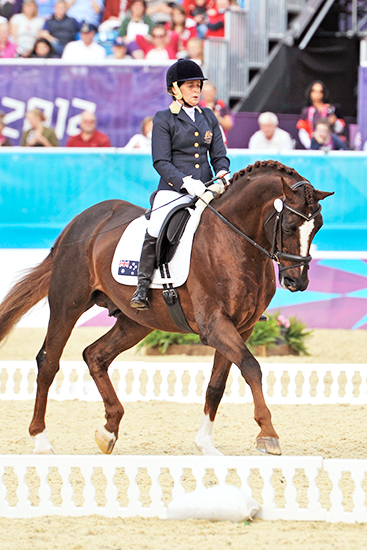
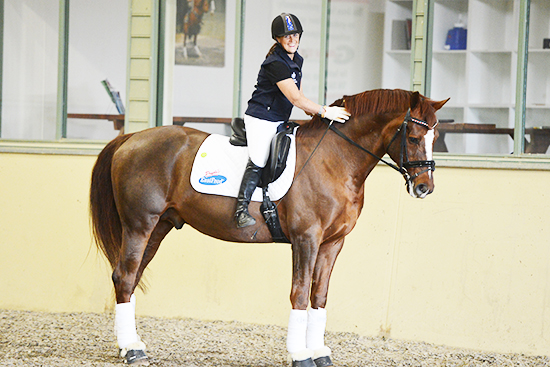
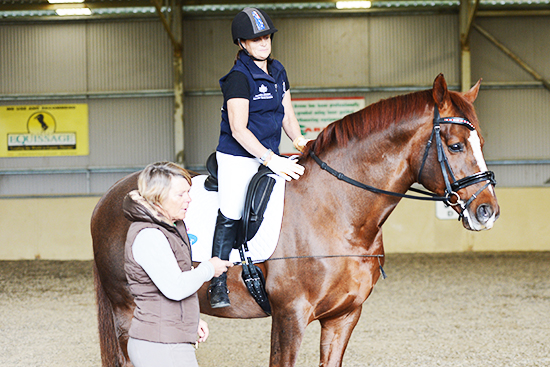
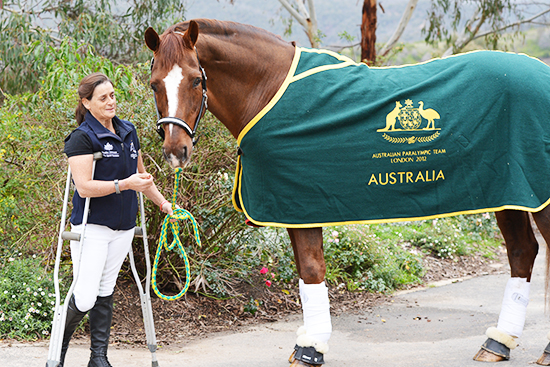
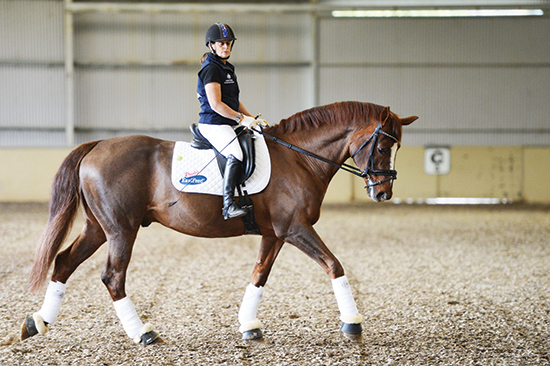
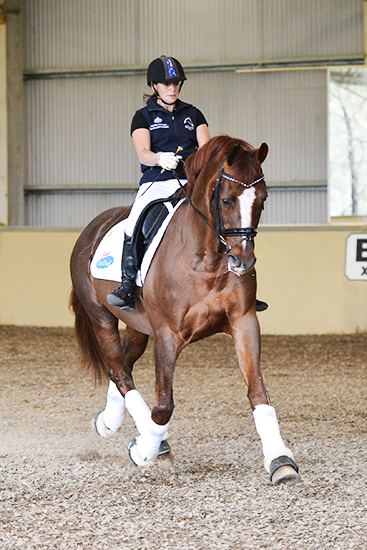
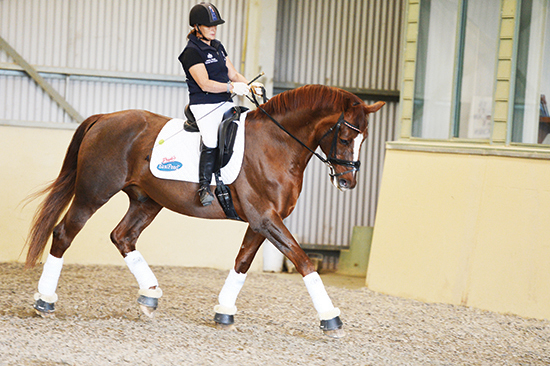
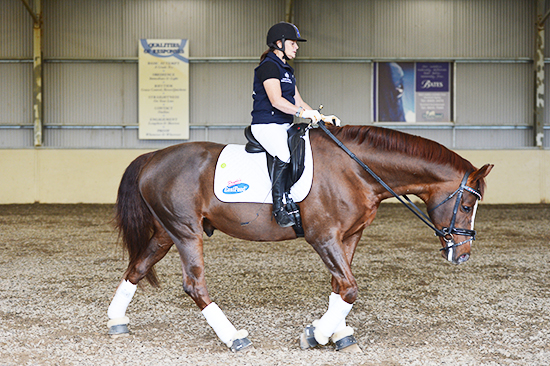
Congratulation to everybody involved to get this horse to London!
I particularly must praise Jutta Rosenblatt who produced this horse for a youngster to PSG at Vollrath Hanoverian Stud in New Zealand. We bought this beauty at age 2 1/2 and imported to NZ levings us beautiful mares to further our breeding programme.
Berny Maubach, Stud master at Vollrath Hanoverian Stud!